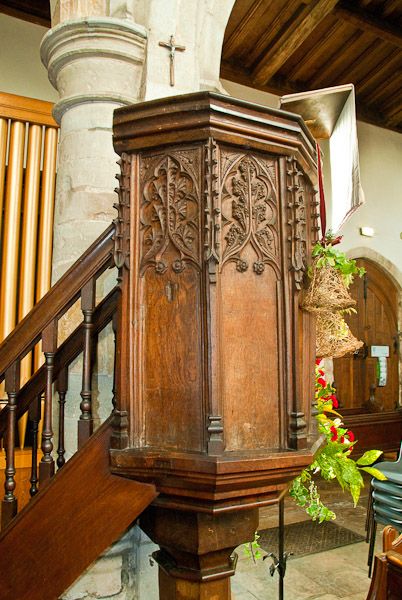Illustrated Dictionary of British Churches - Pulpit Definition
History and Architecture
- Aisle
- Altar
- Ambulatory
- Angel Roof
- Apophyge
- Apse
- Arcade
- Arch
- Archivolt
- Base
- Battlement
- Bay
- Belfry
- Bell Tower
- Bellcote
- Bench End
- Board Bell Turret
- Body
- Boss
- Box pew
- Bracket
- Broach Spire
- Buttress
- Canopy
- Capital
- Cartouche
- Chancel
- Chancel Arch
- Chancel Screen
- Chantry
- Chapel
- Chapter House
- Choir
- Clerestory
- Cloister
- Communion Rail
- Compound Column
- Consecration Cross
- Corbel Head
- Crossing
- Crypt
- Early English
- Easter Sepulchre
- Effigy
- Fan Vaulting
- Font
- Font cover
- Funerary Helm
- Gallery
- Gargoyle
- Gothic
- Green Man
- Grotesque
- Hatchment
- Herringbone
- Hogback Tomb
- Holy Water Stoup
- Hunky Punk
- Jesse Window
- Kempe Window
- Lady Chapel
- Lancet
- Lectern
- Lierne
- Lych Gate
- Misericord
- Monumental Brass
- Mullion
- Nave
- Ogee
- Organ
- Parclose Screen
- Parish Chest
- Pendant
- Perpendicular Gothic
- Pew
- Pinnacle
- Piscina
- Poor Box
- Poppy Head
- Porch
- Priest's Door
- Pulpit
- Purbeck Marble
- Quire
- Rebus
- Reliquary
- Reredos
- Retable
- Romanesque
- Rood
- Rood Loft
- Rood screen
- Rood Stair
- Rose Window
- Round Tower
- Sanctuary
- Sanctuary Knocker
- Saxon Period
- Scratch Dial
- Sedilia
- Spire
- Statue Niche
- Stoup
- Tomb Recess
- Tracery
- Transept
- Triforium
- Tympanum
- Undercroft
- Vaulting
- Victorian Gothic
- Wall Monument
- Wall Painting
- Wheel Window
Pulpit
A raised structure, usually enclosed, from whioch the clergyman delivers his sermon and addresses the congregation. The earliest pulpits were known as 'ambos'. The platform on which the clergyman stands is reached by a set of steps, which are often crved in larger pulpits. A pulpit may be free-standing or attached to a wall. It is frequently located near the chancel arch, at the east end of the nave. More elaborate pulpits are faced with highly decorate wooden panels, and may be topped by a canopy or tester. One particular form of pulpit design is the wine-glass style, so named because the pulpit stands atop a very slender central column, giving it the appearance of a top-heavy wine glass.
Most pulpits are fairly low, but in some Georgian churches they were elevated to extraordinary heights, and might be as high as three levels, or storeys high. Thus you might read about 'double decker', or 'triple decker' pulpits. One example of a triple decker pulpit that I am aware of is that at Teigh, in Rutland.
Related: Arch Canopy Chancel Chancel Arch Nave








